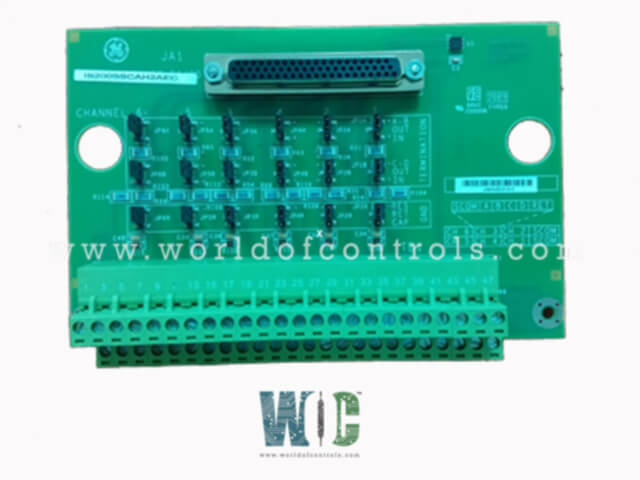SPECIFICATIONS
Part No.: IS200SSVPH2A
Manufacturer: General Electric
Country of Manufacture: United States of America (USA)
Size: 33.02 cm high x 17.8 cm wide
Technology: Surface-mount
Temperature Operating: -30 to 65oC
Product Type: Servo Input/Output Terminal Board
Availability: In Stock
Series: Mark VIe
Functional Description
IS200SSVPH2A is a Servo Input/Output Terminal Board developed by GE. It is a part of Mark VIe control system. The Servo I/O (SSVP) terminal board is an essential component in the control system for steam turbines, specifically designed to interface with two electro-hydraulic servo valves. These valves are critical for actuating the steam valves, which regulate the steam flow to the turbine. The position of these steam valves is accurately measured using either Linear Variable Differential Transformers (LVDTs) or Linear Variable Differential Reluctance Transformers (LVDRs). These transformers provide precise feedback on the valve position, ensuring accurate control of the turbine.
Features
- The terminal board is engineered to work exclusively with the PSVP I/O pack and the WSVO servo driver. It is incompatible with other components like the VSVO board or the PSVO pack, making it a specialized piece of equipment tailored for specific applications within the turbine control system.
- In terms of redundancy, the terminal board is designed as a simplex terminal board, meaning it operates in a single-channel configuration by default. However, the system can be configured for dual redundancy by using two SSVP boards, with the inputs fanned out externally to ensure continued operation in the event of a single-board failure. For applications requiring Triple Modular Redundancy (TMR), three SSVP boards can be used, with the LVDT inputs fanned out externally. This is accomplished by using jumpers to send the signal from one board to another, ensuring that the system remains highly reliable and resilient against failures.
- Power is supplied to the SSVP board via a single 28 V DC supply connected through plug P28IN. Additionally, plugs JD1 or JD2 are provided for an external trip signal, which can be received from the protection module. This external trip capability adds an extra layer of safety, allowing the system to be shut down quickly in the event of an emergency or fault condition.
Installation Procedure
- Wiring Connections: The sensors and servo valves are directly connected to the TB1 I/O terminal block, which is a critical interface on the SSVP board. This terminal block is secured with two screws, providing a stable connection point for up to 24 terminals. These terminals are capable of accommodating wiring up to 12 AWG, allowing for a robust and reliable connection. To the left of the terminal block, a shield terminal strip is attached to the chassis ground. This grounding strip is crucial for minimizing electromagnetic interference and ensuring signal integrity. For external trip wiring, connections are made via plugs JD1 or JD2. These plugs allow for a straightforward connection to the external trip signals, which are essential for the safe operation of the system in the event of a fault or emergency.
- Servo Output Configuration: Each SSVP servo output is designed to support one coil of a three-coil electro-hydraulic servo-actuator, or paralleled coils from a two-coil servo. This flexibility allows the SSVP to be used in various configurations depending on the specific requirements of the application. To prevent thermal stress on the current driver in the event of a short output, a current-limiting resistor is employed. The value of this resistor is selected by the user based on the rated coil current. Jumper JP1 is used to select the appropriate resistor value for Servo 1, while JP2 is used for Servo 2.
- Power Input and Control: The P28 power input, which supplies power to both the PSVP pack and the WSVO servo driver module, is connected through the SSVP connector labeled P28IN. To manage this power input, a switch labeled SW1 is used. When SW1 is turned to the P28ON position, it enables the P28 bus, allowing power to flow to the connected components. The presence of 28 V DC at the SSVP board is indicated by an LED labeled P28IN. However, the P28ON LED will remain off until SW1 is turned on, indicating that the power bus is active and supplying power to the connected modules.
- Protection and Indicators: The board includes an additional safety feature in the form of a third LED labeled PSVP_ONLY. This LED is designed to illuminate if the PSVO pack is accidentally plugged into the JA1 connector, providing a clear indication of incorrect installation. This feature helps prevent potential damage to the components and ensures that only the correct modules are connected.
The WOC team is always available to help you with your Mark VIe requirements. For more information, please contact WOC.
Frequently Asked Questions
What is IS200SSVPH2A?
It is a Servo Input/Output Terminal Board developed by GE under the Mark VIe series.
What does it mean if the output servo current is out of limits or unresponsive, causing a fault?
This indicates a potential issue with the servo valve operation. Check wiring, current limiting resistors, and system configuration. Use the ToolboxST application to diagnose and reset the fault if the issue is resolved.
What happens if the regulator feedback (LVDT) signal is out of limits?
If the LVDT signal is out of limits, the system will remove the faulty sensor from feedback calculations if there are two sensors available, using the good sensor instead. This fault can be diagnosed and reset through the ToolboxST application.
